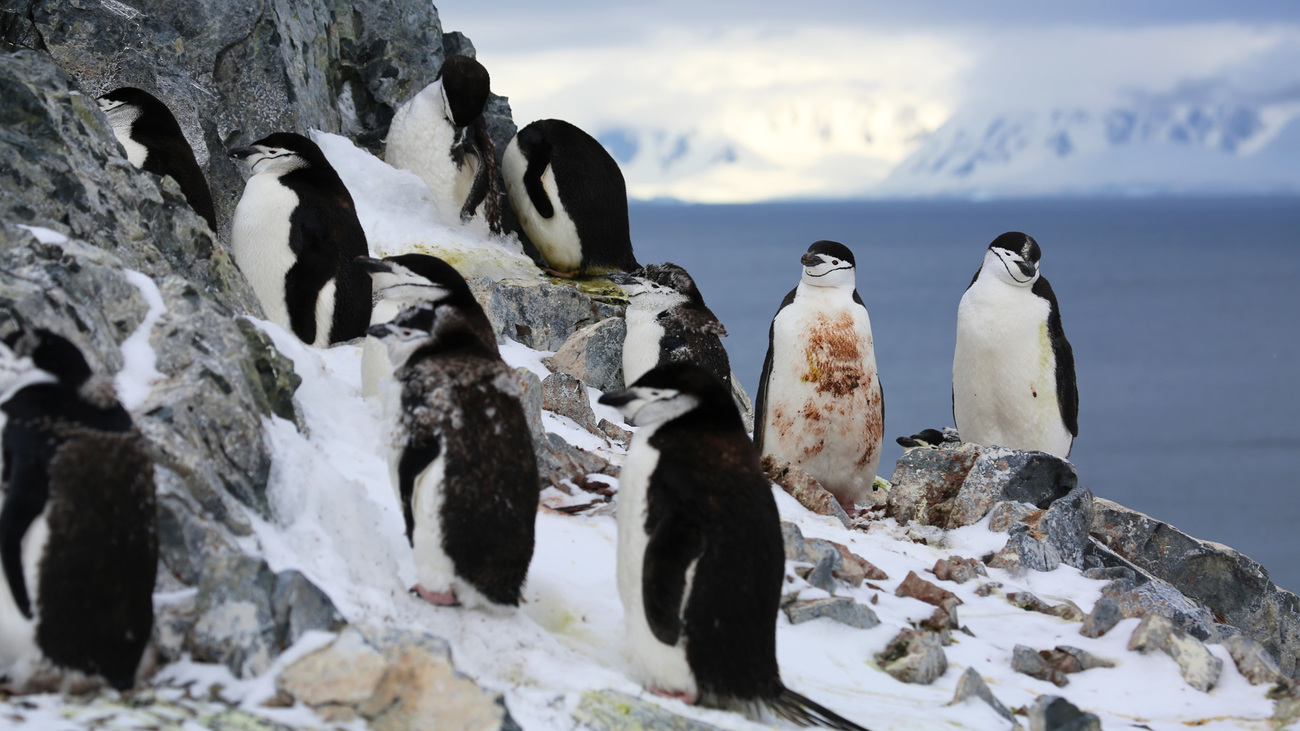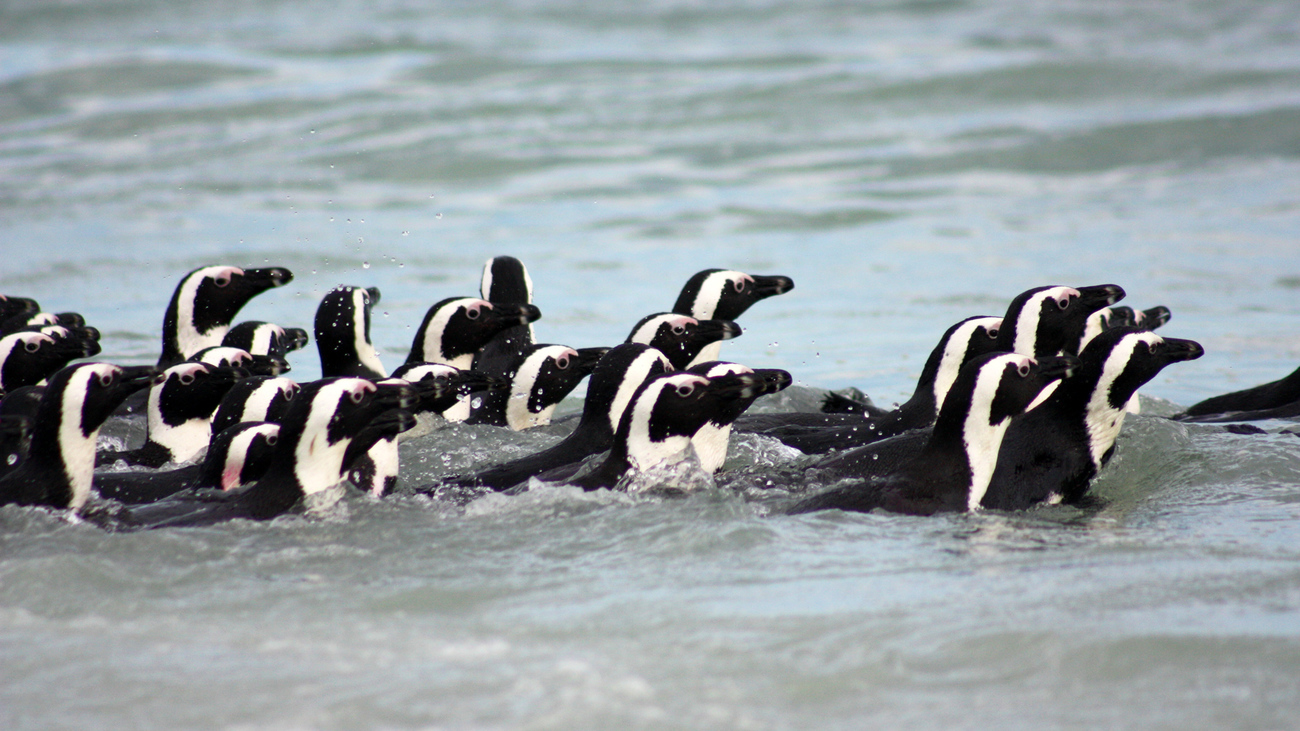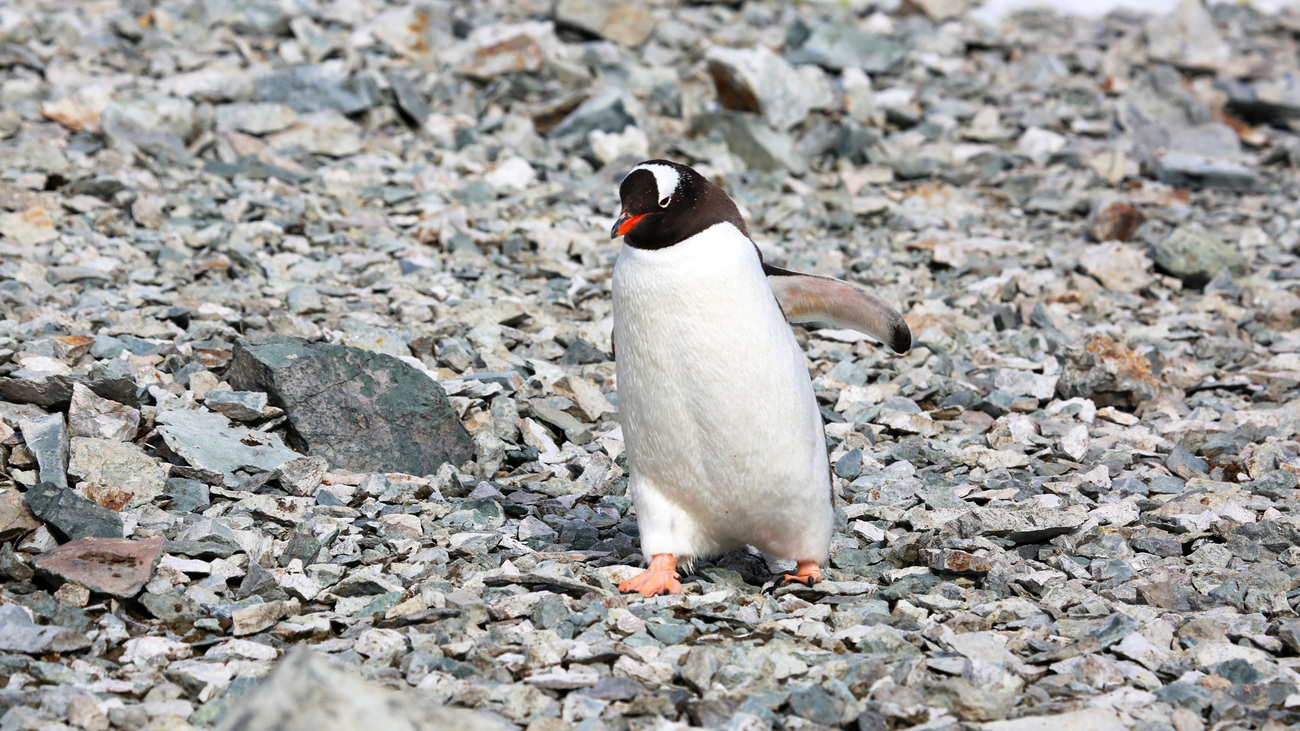Penguins
Penguins are flightless birds often associated with cold temperatures and icy habitats. The most iconic species is the emperor penguin, with its striking black and white feathers and bright yellow accents.
While many penguins live in Antarctica, other species, such as the Galapagos penguin, live much closer to the equator in very warm temperatures. Penguins also range greatly in size, with the smallest, the little penguin (also called the fairy penguin or blue penguin), reaching just 35 centimeters in height, while the emperor penguin can grow as tall as 115 centimeters.
Penguins are known for their fascinating breeding habits. They are largely monogamous, with some pairs staying together for up to 13 years. They come ashore to mate and lay eggs, with both parents helping with incubation. When the egg hatches, both parents hunt for food and use their unique calls to locate their chick upon their return.
As animals that live both at sea and on land, penguins play a vital role in supporting both ecosystems. Because they eat a seafood diet but spend much of their time on land, they fertilize the landscape with plant nutrients from the ocean like nitrogen, phosphorus, and organic carbon. Penguins are an important part of the food chain, as a range of predators (including leopard seals, orcas, and seabirds in cold climates, and pumas, mongooses, and crabs in hot climates) hunt penguin eggs, chicks, and mature adults for food.
What is a penguin’s scientific name?
Penguins belong to the Sphenisciformes order, which describes their wedged shape. Here are the scientific names of each penguin species:
● The emperor penguin is known as Aptenodytes forsteri, meaning “featherless diver discovered by J.R. Forster.”
● The king penguin is referred to as Aptenodytes patagonicus, meaning “wingless diver from the Patagonia region of South America” (one of the areas where king penguins live).
● The Galapagos penguin is called Spheniscus mendiculus, meaning “wedged little beggar,” though the reason for this is uncertain.
Are penguins endangered?
According to the IUCN, the conservation statuses of the 18 penguin species vary from “least concern” to “endangered,” though commercial fishing, bycatch, climate change, pollution, and habitat degradation threaten all penguins.
The most endangered penguins include yellow-eyed penguins, erect-crested penguins, African penguins, Northern rockhopper penguins, and Galapagos penguins, the last of which currently have the lowest numbers—around 1,200 mature individuals left in the wild.
Where do penguins live?
Penguins live predominantly in the Southern Hemisphere and are found in South Africa, Chile, Peru, Australia, and New Zealand. However, penguins in the Galapagos Islands do venture above the equator.
The most well-known penguin species, including emperor penguins, adélie penguins, chinstrap penguins, and gentoo penguins, live around Antarctica, which is why penguins are commonly thought to live only on the ice. However, penguins also live in much warmer climates and frequent the sandy and rocky shores of tropical islands.
Threats
Penguins face numerous threats caused by (or connected to) human activity, including fishing and bycatch, pollution, habitat degradation, and climate change.
Bycatch
Commercial fishermen leave giant nets in the ocean to catch their fish, but penguins and other non-target animals are often caught in them too. Entanglement can injure penguins and even cause drowning.
Overfishing can also affect the amount of food available to penguins and lead to increased competition between species.
Pollution
As plastic waste continues to pollute our oceans, more and more penguins accidentally ingest it. Plastic can cause not only choking but also blockages in the gut, and it can intoxicate vital organs. It can also cut penguins’ flesh and cause infections.

Habitat degradation
From human expansion and development to the introduction of non-native species, penguins are threatened by habitat degradation across their different ranges.
In the Galapagos Islands, for example, non-native species, such as rats, cats, dogs, and mosquitoes, prey on penguins and also infect them with fatal diseases.
In other areas, agricultural practices and livestock have damaged the vegetation in penguin breeding grounds, causing higher levels of mortality in penguin chicks who can’t find protection when their parents leave them to go fishing.
Climate change
Penguins are affected by ENSO (El Niño-Southern Oscillation) events, which affect the temperatures in the Pacific Ocean every few years. During these events, temperatures can change by up to three degrees Celsius, and climate change might increase the frequency of ENSO events.
The long-term effect of temperature changes on penguins and their habitats is still uncertain, and it’s difficult for scientists to measure or predict them. However, one short-term effect is food availability. Rockhopper penguins, for example, are struggling to feed themselves and their chicks.
FAQs
Can penguins fly?
No, penguins cannot fly in the air. However, many people compare their swimming skills to flying through the water. They can reach up to 25 miles per hour and maneuver with great accuracy.
Do penguins have knees?
Penguins do have knees, but they aren’t visible. The visible joint is actually their ankle, while their knees are tucked up inside their body cavity. This skeletal structure helps them move gracefully through water, though it does cause them to waddle on land.
Are penguins birds?
Penguins are birds, even though they don’t fly. Three main characteristics make an animal a bird, and flying isn’t one of them. Birds simply need to be warm-blooded vertebrates, lay hard-shelled eggs, and have feathers.
Though most birds have hollow bones, penguins have developed solid bones to help them dive. Because of their chosen habitat, they have evolved to swim rather than fly.

What do penguins eat?
Penguins eat exclusively seafood, and their favorites include fish, squid, and crustaceans. Smaller species also dine on krill—tiny shrimp-like crustaceans no longer than six centimeters.
Do penguins have feathers?
Penguins do have feathers—they’re just more densely packed and oily than the feathers of most other birds. This gives their bodies a slick, smooth appearance and helps them stay warm and swim well.
Once a year, penguins shed their feathers in an event called a “catastrophic molt.” Over the course of a few weeks, penguins shed all of their feathers all at once. During this time, they are forced to fast, as they cannot hunt without their waterproof feathers.
What is a group of penguins called?
There are multiple words to describe a group of penguins, each used in a specific case.
● A group of penguins on land is referred to as a “waddle.”
● A group of penguins that has gathered for the breeding season or other social events is often called a “colony” or a “rookery” due to the amount of time they’ll spend together. It’s common for penguins to return to the same sites each year.
● A “crèche” of penguins refers to the large groups of chicks that huddle together for protection while their parents are away hunting.
● A group of penguins in the water is called a “raft.” When not diving for food, they often float on the water’s surface to rest.
Do penguins mate for life?
Though it is said that penguins mate for life, the reality is a little more complicated. Both the male and the female play important roles in incubating and looking after penguin chicks, so they do work together during the reproduction and rearing process. However, between 10 and 40% of pairs don’t stay together for more than one mating season.
Couples separate for several reasons. For example, if one penguin turns up late to the breeding area one year, its former mate will choose a new mate. A pair may also separate if they don’t synchronize or work together effectively while raising their first chick.
However, when a pairing is successful and they continue to attend the same breeding areas each year, they will choose to keep reproducing together. As far as experts can tell, there’s no real reason for this other than to avoid competing for a new partner.
How long do penguins live?
The different species of penguin all live for around 15 to 20 years in the wild.
Do penguins have teeth?
Penguins don’t have teeth, but they do have incredibly pronounced papillae (structures on the tongue that house taste buds and help grip food). On the human tongue, papillae appear as little bumps, but on a penguin’s tongue, they are large and hook-shaped. They help penguins swallow fish easily and safely.

Are penguins endangered?
According to the IUCN, there are five endangered species of penguin, each with varied population counts. The most populous is the northern rockhopper penguin, with around 413,700 mature individuals. However, studies and records indicate that there has been a rapid decline in their numbers in recent years. Before 1995, there were millions of Northern rockhopper penguins.
Around 150,000 mature erect-crested penguins, 41,700 African penguins, 2,600 to 3,000 yellow-eyed penguins, and 1,200 mature Galapagos penguins remain.
Their declines can be attributed to numerous factors, including increased commercial fishing, bycatch and entanglement, pollution, habitat degradation, and climate change.
How can you help?
Penguins are vulnerable due to the growing threats they face, including climate change, bycatch, and habitat degradation.